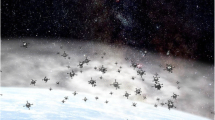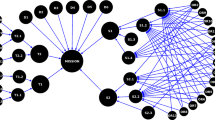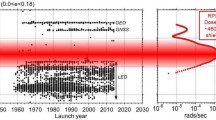Abstract
Space electromagnetic and plasma sensor is a proposed space payload consisting of an electric field vector sensor—a tri-axial arrangement of monopoles in a mutually orthogonal configuration—and a magnetic field vector sensor, which is a tri-axial arrangement of mutually perpendicular loop antennas. Both operate between 0.5 and 20 MHz in order to acquire the complete 3D polarization matrix. The antennas, which are meant to be electrically short, are matched with a high input impedance amplifier, followed by gain blocks, filters and a six-channel data acquisition system. Some of the proposed goals of the project include study of the low frequency Sun, plasma interactions between the solar wind and Earth’s magnetosphere, lunar atmosphere, and radio emission from other planets within the solar system. This article describes the construction of a laboratory prototype and preliminary calibration results.









Similar content being viewed by others
Notes
Antennas whose conducting elements are typically of lengths l ≪ 0.1λ.
While the practical beam solid angle of a monopole or loop antenna would be different especially when placed on the surface of a spacecraft, the difference in total power received is small and is considered negligible here for sake of convenience.
Total power calculated as = \( 10\log_{10} \left( {kT\Delta \nu G_{\text{A}} } \right)\; {\text{dBW}} \)
References
J.-L. Bougeret et al., Waves: the radio and plasma wave investigation on the wind spacecraft, Space Sci. Rev., 71(1–4) (1995) 231–263.
D.A. Gurnett et al., The Cassini radio and plasma wave investigation. The Cassini-Huygens Mission, Springer, Berlin (2004) 395–463.
G. Shaifullah et al., The Lunar electromagnetic and plasma sensor (LEAPS): a proposed space based radio astronomy and space plasma measurement system, 39th COSPAR General Assembly, Mysore, C5.1-0057-12 (2012).
J.E.S Bergman et al., ELVIS—electromagnetic vector information sensor, DGLR International Symposium “To Moon and Beyond”, Bremen, Germany, 2005. ar**v:astro-ph/0509864.
J.P. Basart, J.O. Burns, B.K. Dennison, K.W. Weiler, N.E. Kassim, S.P. Castillo and B.M. McCune, Directions for space-based low-frequency radio astronomy: 2, Telesc. Radio Sci., 32(1) (1997) 265–275, doi:10.1029/96RS02408.
D. Oberoi and J.-L. Pinçon, A new design for a very low frequency spaceborne radio interferometer, Radio Sci., 40 (2005) RS4004, doi:10.1029/2004RS003211.
S. Jester and H. Falcke, Science with a lunar low-frequency array: from the dark ages of the Universe to nearby exo-planets, New Astron. Rev. 53(1) (2009) 1–26.
J.R. Pritchard and A. Loeb. Constraining the unexplored period between the dark ages and reionization with observations of the global 21 cm signal, Phys. Rev. D 82(2) (2010) 023006.
C.A. Balanis, Antenna theory: analysis and design, Wiley, London (2010) pp. 176–178, 465–467.
S.W. Ellingson, J.H. Simonetti and C.D. Patterson, Design and evaluation of an active antenna for a 29–47 MHz radio telescope array, IEEE Trans. Antennas Propag., 55(3) (2007) 826–831.
R. Bradley and C.R. Parashare, Evaluation of the NRL LWA Active Balun Prototype, NRAO Electronics Division Technical Note, Series No. 220, (2005). http://www.gb.nrao.edu/electronics/edtn/edtn220.pdf.
G.H. Tan and C.H. Rohner, Low-frequency array active-antenna system, astronomical telescopes and instrumentation, International Society for Optics and Photonics, Bellingham (2000).
B.C. Hicks et al., A wide-band, active antenna system for long wavelength radio astronomy, Publ. Astron. Soc. Pacific, 124(920) (2012) 1090.
S.W. Ellingson, Antennas for the next generation of low-frequency radio telescopes, IEEE Trans. Antennas Propag., 53(8) (2005) 2480–2489.
M.L. Kaiser et al., WIND/WAVES observations of man‐made radio transmissions, Geophys. Res. Lett., 23(10) (1996) 1287–1290.
J.K. Alexander, M.L. Kaiser, J.C. Novaco, F.R. Grena and R.R. Weber, Scientific instrumentation of the radio-astronomy-explorer-2 satellite. Astron. Astrophys., 40 (1975) 365–371.
H.V. Cane, Spectra of the non-thermal radio radiation from the galactic polar regions, Mon. Notices R. Astron. Soc., 189(3) (1979) 465–478.
E. Bruun, Feedback analysis of transimpedance operational amplifier circuits, IEEE Trans. Circuits Syst. I: Fundam. Theory Appl., 40(4) (1993) 275–278.
J.J. Condon and S.M. Ransom, Essential radio astronomy. Princeton University Press (2016).
S. Gujare et al., FPGA based data acquisition and analysis system, 2012 1st International Symposium on Physics and Technology of Sensors (ISPTS), IEEE (2012).
S. Gujare et al., Development of data acquisition and analysis system on Virtex 5 FPGA, Volume 2, Issue 8, IJARCSSE (2012). http://casper.berkeley.edu/.
R.G. Lyons, Understanding digital signal processing, Pearson Education, Upper Saddle River (2010) pp. 135–160, 671–730.
B. Richards et al., A 1.5 GS/s 4096-point digital spectrum analyzer for space-borne applications, Custom Integrated Circuits Conference, 2009, CICC’09, IEEE (2009).
Acknowledgments
We would like to thank the Physical Research Laboratory (PRL) for PLANEX Grant #GOI-A-574 under which this work was carried out along with some of the other students who helped out: Ankur Divekar, Gaurav Jagtap, Zahid Mohammed, and Minakshi Salpure. We would also like to thank SAC for their support thus far and for hel** us test the prototype. We would like to express gratitude to Prof. P. Janardhan for his continued support on the project. Special thanks to our collaborators at the Swedish Institute of Space Physics, Dr. Jan Bergman and Mr. Lennart Ahlen, for the initial guidance and support in making the proposal and mission concept during the late 2000s and to the anonymous referee whose valuable comments helped improve the quality and content of this article.
Author information
Authors and Affiliations
Corresponding author
Rights and permissions
About this article
Cite this article
Makhija, K., Borade, R., Shaifullah, G. et al. Space Electromagnetic and Plasma Sensor (SEAPS): A Laboratory Prototype for a Space Payload. MAPAN 31, 283–289 (2016). https://doi.org/10.1007/s12647-016-0188-y
Received:
Accepted:
Published:
Issue Date:
DOI: https://doi.org/10.1007/s12647-016-0188-y




